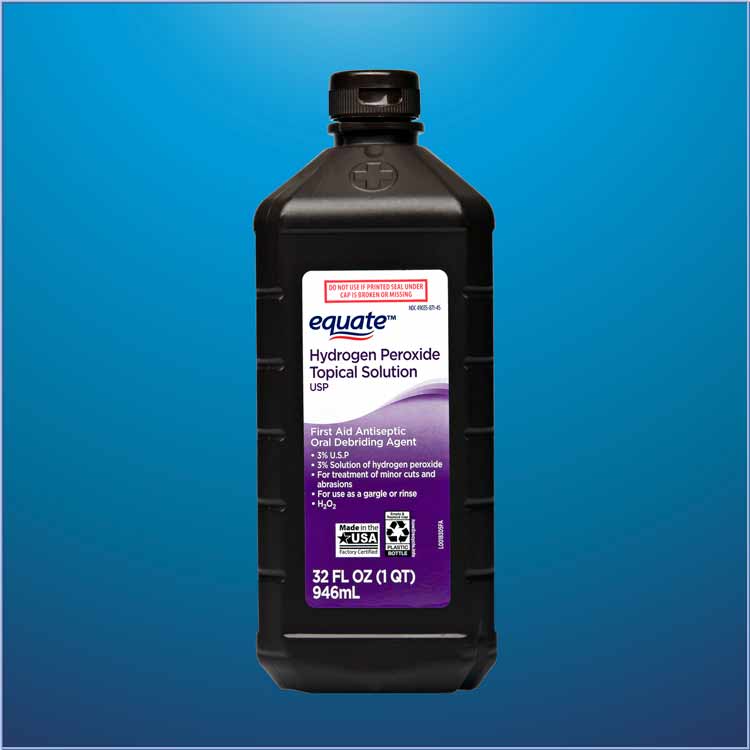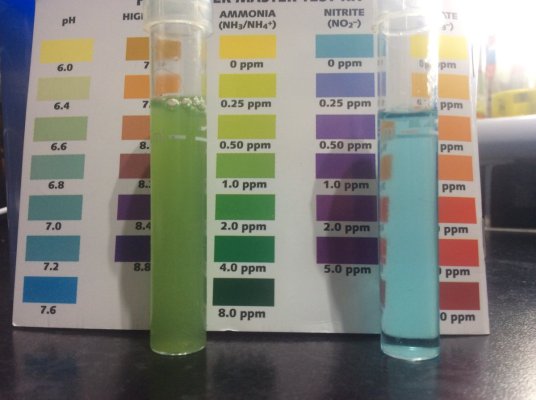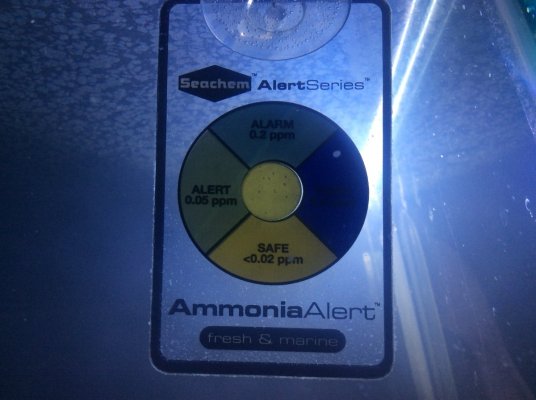I beg to differ . I had a gha outbreak and dosed the 1ml per 10g for 5 nights with 1.5ml of microbacter7 in the day and gha was gone in a week with no ill affects.It is basically a free-oxygen radical - added to your tank - which will attach to anything - an immediately become inert (inactive). I do not think it helps with GHA at all
Navigation
Install the app
How to install the app on iOS
Follow along with the video below to see how to install our site as a web app on your home screen.
Note: This feature may not be available in some browsers.
More options
You are using an out of date browser. It may not display this or other websites correctly.
You should upgrade or use an alternative browser.
You should upgrade or use an alternative browser.
Is there a dummy's guide to how hydrogen peroxide helps with nuisance algae?
I believe that. we've charted it about 150 times above, it's just the minority outcome % meaning if you try and get that same outcome for 20 other people only 1 will have that outcome. the others will have it grown back by August 15th.
what I'm certain about is the non effect to filtration bacteria. that's about twelve years of work above showing no such issue. if someone sets up a plastic scape qt tank, cycles it, and then runs peroxide tests on it I don't expect that to work like it does in a filthed up organic-waste loaded reef tank. context matters in my opinion for peroxide discussions
what I'm certain about is the non effect to filtration bacteria. that's about twelve years of work above showing no such issue. if someone sets up a plastic scape qt tank, cycles it, and then runs peroxide tests on it I don't expect that to work like it does in a filthed up organic-waste loaded reef tank. context matters in my opinion for peroxide discussions
How much peroxide do you want me to put in ?(40 Ltr QT), fresh cycle.if someone sets up a plastic scape qt tank, cycles it, and then runs peroxide tests on it
hey neat, your call. I hate to degrade it any if you're going to use it but I truly don't think with any practical application you can cause anything more than a 48 hour delay. what a neat rare timing to get to see. in brainstorm you might see if one mil per ten gallons/the universal applied rate/does anything in the QT and if that's boring you could dose it in measured increments to see what it takes to truly kill the system too, not sure how far you want to take the test. Your api is benched legit though so anything you find on the api scale/with a little bit of extra lag time assumed since it's not digital/I would accept as legit for sure. what you just posted for the api ammonia reading in your aged display tank sure looks pretty yellow to me.
Right, I’ve got 12% so I’ll put 0.25ml in now. If the wife finds out I’m mincemeat though. I’m interested to see if this “stressor” will cause a settlement event to be honest.hey neat, your call. I hate to degrade it any if you're going to use it but I truly don't think with any practical application you can cause anything more than a 48 hour delay. what a neat rare timing to get to see. in brainstorm you might see if one mil per ten gallons/the universal applied rate/does anything in the QT and if that's boring you could dose it in measured increments to see what it takes to truly kill the system too, not sure how far you want to take the test. Your api is benched legit though so anything you find on the api scale/with a little bit of extra lag time assumed since it's not digital/I would accept as legit for sure. what you just posted for the api ammonia reading in your aged display tank sure looks pretty yellow to me.
- Joined
- Dec 28, 2016
- Messages
- 22,859
- Reaction score
- 21,991
It's fine - I'm curious, though, how do you know it wasn't the microbacter 7 that did the trick? Additionally, there is a difference between 'a GHA outbreak' and a tank in which each rock is covered by unwanted algae. When I hear 'a GHA outbreak', I assume it's a major outbreak, not a small area (note - I don't know how much was there. I remember reading a post saying 'what should I do about my horrible Dino outbreak' and it was like a square inch of browning on the sand.I beg to differ . I had a gha outbreak and dosed the 1ml per 10g for 5 nights with 1.5ml of microbacter7 in the day and gha was gone in a week with no ill affects.
IMHO - if one indeed has a tank with a significant, major outbreak, that H2O2 will not make it go away in 7 days.
- Joined
- Dec 28, 2016
- Messages
- 22,859
- Reaction score
- 21,991
So in my understanding H2O2, or H-O=O-H, is indeed a strong oxidizer just like O3.
What happens is it binds to organics, for example carbon chains, and splits them up:
C-C-C-C-C-C + H-O=O-H ==> C-C-C-O-H + H-O-C-C-C
Very easy representation, not exact ofcourse, and the peroxide can bind anywhere in the organic molecule.
Reactions could be very different depending on the molecule it reacts with, but this is the basis.
This is actually a very interesting comment. For example - other posters state they can guarantee that in nearly every case, that Ammonia consumers are not damaged. However, pseudomonas - and many others are in fact catalyst positive - and they also consume ammonia. So it may very well be that heterotrophs are doing the job once if the others are 'damaged'.All life is made up of these organic molecules on a cellular level, think about cell walls, DNA, cell organels,...
If the cell wall is partially destroyed, the cell dies.
So if peroxide binds with enough organics, life is killed.
The result of this binding is a new organic molecule, an alcohol (typically carbon chain with OH at the end) in many cases, and it is in most cases not toxic.
So you could say once H2O2 binds, its effect is fully gone. In my opinion O3 does nearly thesame.
I like to compare it with burning wood with fire. It oxidises the organic matter, and the residue is mostly non-toxic.
Now the interesting part is that oxigen radicals are everywhere in nature. Like it is a byproduct of photosynthesis. Scientifically named, ROS (reactive oxigen species: O3, H2O2, O*,...) get formed easily and therefore many organisms have adapted to break it down.
Higher organisms are in many cases resistant as they have outer layers that protect them, and they have antioxidants (carotene, vitamin-C and many others) that break down the ROS. that means single cell organisms like dino's, algae, or bacteria are much more susceptible.
but not in every case. Like some strains of bacteria have katalase, an enzyme that breaks down H2O2. And will therefore be much more resilient than most.
I love to use H2O2 as a treatment against bacterial infections.
Sometimes my SPS start to STN, and i use a pipette to put some H2O2 on the dead area and the inch above. It works certainly in some cases.
Even better is brown jelly in euphyllia's, I have many large colonies with 20-150 heads, and had a brown jelly breakout.
You have to be quick, but once 1 head gets infected, cut out as much as you can, suck out most of the flesh and put H2O2 in with a pipette. It burns all leftover, and disinfects.
I have a 1000 gallon with large corals, so I cannot easily take out whole corals and dip them, so I like to do in tank spot treatments like this and they really help.
I did save a non-branching euphyllia even, A large colony, 1/3 was gone but I could stop the brown jelly spreading by sucking out the infected tissue and putting H2O2 in 3 times a day for 2 days. At the end not too many deaths from the brown jelly.
Whole tank treatments are different for me, you will kill a lot of the one celled organisms, but others like the catalase positive bacteria will stay alive. Result is you push your microbiological diversity a lot in the direction op catalase positives, and others that can break down H2O2. Is it bad? No idea! But microbiological diversity in your reef is a very important topic that we know too little about.
EDIT - Catalyst = catalase
Last edited:
- Joined
- Dec 28, 2016
- Messages
- 22,859
- Reaction score
- 21,991
I went to the thread you quoted above. Here is what you requested: "For this thread I wanted to follow a different path. rather than posting something and it turning into a theory back and forth, the ideal would be to have someone that has a spot of algae they can't beat, we do a little wizardry in pm, they show back up with the spot in a couple days to show the loss of it. then we talk about how that worked, if any of you know don't spoil it lets have fun. for once we'll post proof first, its something you already have in your house but again no guesses its more fun to kill algae first.
Peroxide saves my Tank! With pics to Prove It!
www.nano-reef.com

Reef2Reef Pest algae challenge thread hydrogen peroxide
What you are really in for: Hand cleaning, hard work siphon and rasp-removing of accumulations and invasions outside the tank and doing massive water changes is 90% of this thread, peroxide is 10%. We almost never dose peroxide into the tank water, this is a you-work-physically-hard as catch-up...www.reef2reef.com
pico reef pest algae problem challenge - Reef Central Online Community
pico reef pest algae problem challenge Nano Reefsreefcentral.com
that's 500 or so peroxide jobs. no mistakes
and, it's all anecdote. but with perfect control of losses if directions are followed
and zero tank recycles
and no loss of filter bacteria.
so if a reefer wanted to do a peroxide job and know the % likelihood outcome ahead of time, would it be best to consult actual jobs ran, or some article with zero jobs ran for others/
in the case of peroxide in reefing, anecdote wins by a landslide because anecdote controls all those reefs and the future ones who want work done.
you don't have to worry about loss of filtration bacteria with normal peroxide use, #1 takeaway rule. try dosing peroxide into a fully cycled display reef hooked up to a seneye and you'll see some neat results; instant boost of nitrification rates.
I think it's because oxidizers like the extra 02 boost, not that peroxide does much to bacteria housed in a bioscum sheath.
if anyone has a single spot or area of invasive micro or macro algae in their tank that they haven't been able to beat following all the usual rules put up a pic and lets run this test."
I didn't go through all 500 'successes' - but this does not seem to relate to 'H2O2' dosing in large tanks? Perhaps I'm wrong.
- Joined
- Dec 28, 2016
- Messages
- 22,859
- Reaction score
- 21,991
I'm curious - how long have you had the 12% H2O2 - and where was it stored. Unless it's brand new, it's not going to be known how much H2O2 you're actually adding. Additionally, there are more bacteria in your tank than only nitrifiers (obligate) - so it will be very difficult to see if there is any effect (whether positive or negative). IMHO. However I'm interested in the resultsRight, I’ve got 12% so I’ll put 0.25ml in now. If the wife finds out I’m mincemeat though. I’m interested to see if this “stressor” will cause a settlement event to be honest.
Probably 12months, kept in the dark, opened probably 3 or 4 times, nearly full, fizzes algae on frag plugs ok. I went the whole hog and dosed another 0.75mls, so that’s the equivalent of 4ml of 3% per gallon (maybe). The bacteria in the newly set up QT tank appear to already be growing off the rocks, must have made there homes already while I wasn’t watchingI'm curious - how long have you had the 12% H2O2 - and where was it stored. Unless it's brand new, it's not going to be known how much H2O2 you're actually adding. Additionally, there are more bacteria in your tank than only nitrifiers (obligate) - so it will be very difficult to see if there is any effect (whether positive or negative). IMHO. However I'm interested in the results
- Joined
- Dec 28, 2016
- Messages
- 22,859
- Reaction score
- 21,991
One problem with H2O2 - if you take a bottle of H2O2 (lets say 3%) - that has been sitting around in a cabinet for 6 months - you may not be adding much if any H2O2. (if the bottle has been opened). Its different for sealed unopened bottles.sum takeaway of that thread: if you do peroxide for algae by dumping it in your tank, it's not going to work long term unless you get lucky. more precise means are needed then it becomes one of the handiest algae tools I've ever seen. those were the rough shod work years in development above.
leaving filthy sand underneath and algae prone tank is a big mistake peroxide has nothing to do with, enter rip cleaning as a paired and highly effective means of algae control/removing filthy waste clouded stores of algae fuel matters more than the peroxide for the future prognosis for the tank...that and light intensity control, one of the largest causes of algae issues in the hobby: again having nothing to do with peroxide, your guessed at nitrate or po4 levels etc. with clean sand, corrected lighting, and targeted surgical application of peroxide we can go really far nowadays. we dump nothing into your tank.
I don't recommend dumping it in the tank not due to danger, but because much better ways of using it are on file. that above shows the general safety involved with dumping in one mil per ten gallons into a reef tank. Jay's article was not built from reef tanks; hence his claim of worry for the filter bacteria. context matters.

Hydrogen Peroxide Shelf Life Before and After Opening
Learn about the shelf life of hydrogen peroxide, how long it's good after opening, and the factors that influence how long it lasts.
- Joined
- Dec 28, 2016
- Messages
- 22,859
- Reaction score
- 21,991
Thanks - check out this article:Probably 12months, kept in the dark, opened probably 3 or 4 times, nearly full, fizzes algae on frag plugs ok. I went the whole hog and dosed another 0.75mls, so that’s the equivalent of 4ml of 3% per gallon (maybe). The bacteria in the newly set up QT tank appear to already be growing off the rocks, must have made there homes already while I wasn’t watchingI doubt it’ll prove anything either to be fair


Hydrogen Peroxide Shelf Life Before and After Opening
Learn about the shelf life of hydrogen peroxide, how long it's good after opening, and the factors that influence how long it lasts.
And PS - this is not meant to criticize what you're doing - only to say the storage conditions after opening can greatly affect the amount of H2O2 thats actually in the bottle.
So, dosing the whole tank - I also don't see how it's going to have any impact on GHA. But direct application definitely works. It's very effective at killing the GHA on the rocks; I've treated rocks before both by spot treating in the tank and by removing the rock and pouring peroxide on it. The downside is it kills just about everything else on the rock too.When I hear 'a GHA outbreak', I assume it's a major outbreak, not a small area
I have a couple powerheads I could do a before/after on if there's any question about it's effectiveness there. Direct peroxide turns GHA white in a few days.
4 mils per ten gallons was among the highest sustained doses we tried for bad algae tanks, so this is quite a test. I predict it will not kill off the bio system and in about 48 hours it should still reduce ammonia just fine. If there was no delay at all that wouldn’t surprise me, no harm at all, and if it did kill the bio system that too is understandable as this is probably the strongest test dose I’ve seen. Your outcome compared to Jays findings is very very helpful for peroxide charting in general.
Was 2ppm NH3+NH4, 12 hrs ago;4 mils per ten gallons was among the highest sustained doses we tried for bad algae tanks, so this is quite a test. I predict it will not kill off the bio system and in about 48 hours it should still reduce ammonia just fine. If there was no delay at all that wouldn’t surprise me, no harm at all, and if it did kill the bio system that too is understandable as this is probably the strongest test dose I’ve seen. Your outcome compared to Jays findings is very very helpful for peroxide charting in general.
Edit - this is comparable to 12 hrs without any peroxide, so I see no noticeable difference.


Last edited:
- Joined
- Dec 28, 2016
- Messages
- 22,859
- Reaction score
- 21,991
Nice - however - if you're using year old peroxide that has been non refrigerated and opened 3-4 times - it's impossible unfortunately to tell how much you've actually added. Plus you've added (If I remember correctly???) heterotrophs - plus fed them plus had a bacterial bloom - suggesting that you have a large heterotrophic population many of which are resistant (almost) completely to H2O2. But I agree with the conclusion that your ammonia dropped
Similar threads
- Replies
- 20
- Views
- 1,557
-
- Poll
- Replies
- 33
- Views
- 1,314
- Replies
- 19
- Views
- 532
- Replies
- 8
- Views
- 552

















